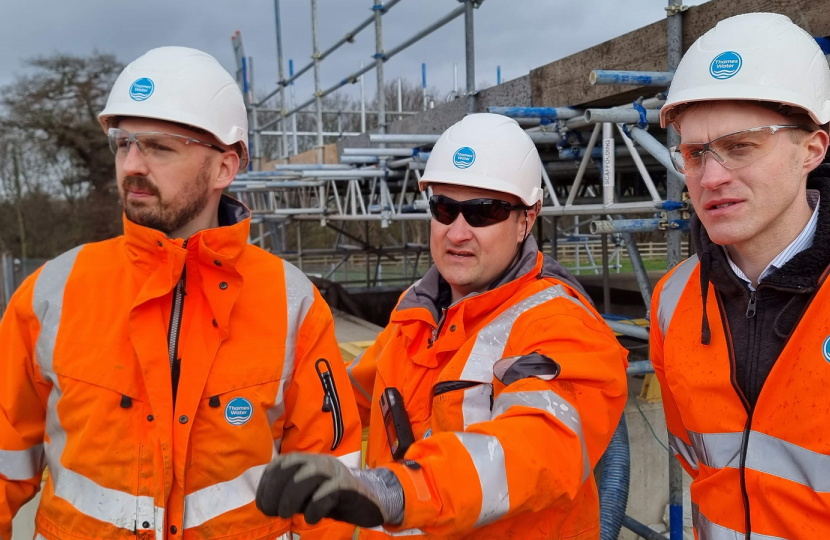
Following on from my meeting with Thames Water’s Sustainability Director Richard Aylard after the passing of the Environment Act at the end of last year, I visited Thames Water’s sewage treatment works in Chertsey and Weybridge to find out more about the work they are doing to prevent future sewage discharges into our rivers.
The Chertsey site is huge – one of the larger Thames Water treatment sites – serving many thousands of constituents in the local area. Not only does it take raw sewage through the sewers, but also takes sewage in via truck from cesspits in the surrounding area. One of the challenges that it faces is that sewage coming in from several local built-up areas moves in slowly, leading the sewage to be very acidic by the time it gets to the plant. This leads to corrosion of the concrete ironwork, and large improvement program is underway to make the plant more resistant to ‘acid sewage’.
The Weybridge site is much smaller but has its own unique challenges such as older equipment that is currently being replaced. Recently the initial filter machinery which separates out junk (such as wet wipes and other things that should not be flushed down the toilet!) had been upgraded.
Both sites have storm overflow systems. When there are heavy downpours of rain, this gets into the sewers and risks overwhelming the plant. There are two ways that the plants can stop this from happening, one is to process the sewage faster, and the other is to put the sewage in temporary holding tanks. Once both of these have been used to maximum capacity the sewage, already having gone through the first filter to pull out the junk, and then the top is skimmed off the top leaving the bulky waste in the plant, to be released as an emergency into the river.
The on-site storm overflow tank at Weybridge had been used that weekend due to heavy rains but thankfully they did not use the storm overflow to release anything into the Wey.
Having seen the sites, and learnt in detail about the processing and challenges, it is clear to me that further improvements are needed to reduce the risk of needing to use storm overflows, which should never need to be used in my constituency.
I believe is absolutely critical that Thames Water meet their obligations under the new Environment Act to prevent totally unacceptable sewage leaks into our local rivers at times of high pressure such as storms, and I am pleased they agree on this point. We have so many beautiful waterside spots in the constituency, around the Thames, Bourne, Abbey, Wey and more, and it is not right that in 2022 they can still be blighted by sewage during storms or heavy rain.
I will therefore be writing to Thames Water as a follow up to this visit, to lay out in detail how they plan to improve both sites with a view to enhancing the capacity to manage with increased water during a storm and prevent future storm overflow discharges. I’ll feedback when I hear back from them.
I am delighted that having requested a round table meeting, it has now been confirmed that next month DEFRA minister Rebecca Pow MP, who has responsibility for flooding in her portfolio, will be attending to discuss sewage flooding (where in my constituency during localised flooding sewage comes out of sewers and toilets) and how we can bring together multiple agencies to establish ownership of this devastating issue that has affected several communities in the Runnymede and Weybridge constituency for far too long. The Minister agreed to organise a roundtable to bring together these organisations such as Thames Water and the EA and discuss specific issues, and I look forward to holding them to account and getting this problem fixed.
For more information on my work on flooding, see: https://www.drbenspencer.org.uk/campaigns/better-protection-flooding and sign up to my newsletter: www.runnymedeandweybridge.news
